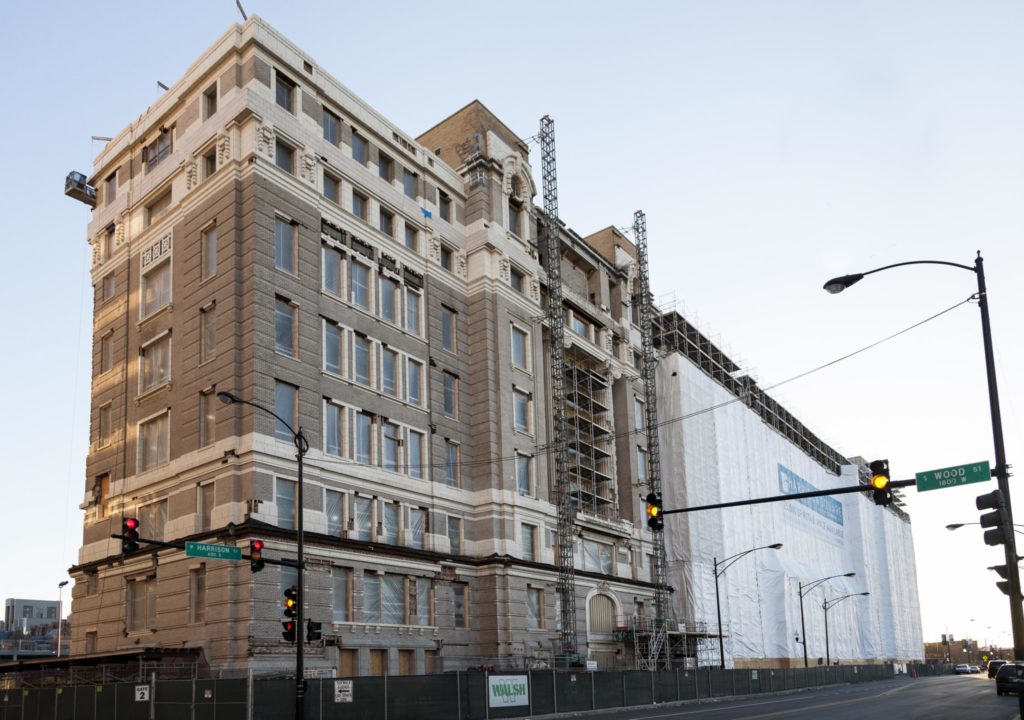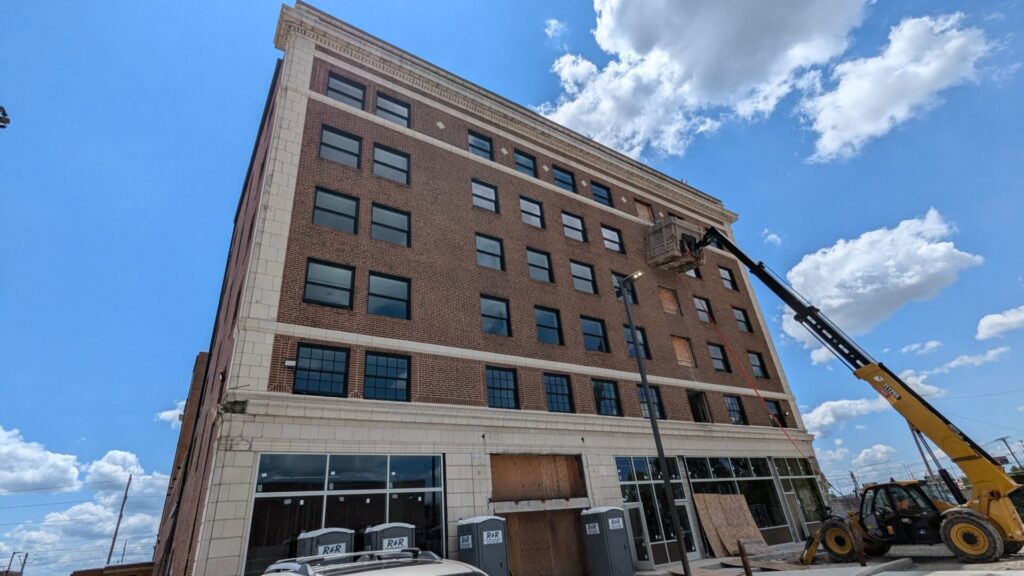(The former Broadview Hotel in East St. Louis during redevelopment. It has been adaptively reused for affordable senior housing.)
April 22, 2025
By Bonnie McDonald, President & CEO
Reusing existing buildings is a vital, effective and scalable climate change mitigation solution. Illinois is a natural testing ground for these solutions with incredible adaptive reuse examples: the formerly vacant Old Post Office and former Cook County Hospital in Chicago, the former Broadview Hotel in East St. Louis and the Ziock Building in Rockford. With our remarkable historic communities, the nation’s foremost architects, planners, sustainable developers and builders, our philanthropic community, world-class research institutions, the headquarters of the Passive House Institute of the U.S. and the birth of environmental justice in Chicago, we can scale up building reuse as an impactful climate change mitigation strategy. Valuing and reinvesting in our existing building supply creates resilient, connected, healthy and prosperous communities.
However, while reusing our historic buildings is a climate-friendly choice, preservationists with an eye on sustainability must consider several additional challenges, especially those of us in Illinois. The construction and operation of buildings account for over 40 percent of all global carbon emissions, the largest greenhouse gas emitting sector. The statistics for Chicago are even more dire, as the built environment is responsible for nearly 70 percent of the city’s carbon emissions. The vast majority of Chicago’s 500,000 buildings were constructed between 60 and 80 years ago, something that we value as preservationists, but is daunting when considering the scale of needed energy efficiency retrofitting. Estimates are that two-thirds of the nation’s 111 million buildings are expected to be in continued use in 2040, when the median age of these buildings will be nearly 65. Making these buildings more energy efficient is essential to reduce carbon emissions.
As I noted in the 2023 Landmarks Illinois publication, “The Relevancy Guidebook: How We Can Transform the Future of Preservation,” we must revisit our overreliance on the belief that simply preserving a building is the “greenest” choice and use an evidence-based approach. This point was made to me early in my relevancy research by Columbia University Professor Erica Avrami, who recently published her forward-thinking, “Second-Order Preservation: Social Justice and Climate Action through Heritage Policy.” Since architect Carl Elefante, FAIA, coined the phrase, “The greenest building is one that is already built,” in 2007, it has become part of the preservation lexicon. Preservationists and the general public alike understood the logic – keeping a building avoids disposing of its material. That is undoubtedly true. However, the phrase is often cited as an absolute when evidence may show needed energy performance improvements to reduce carbon emissions. Avrami joined three other researchers in publishing a thought-provoking paper, “Energy and historic buildings: toward evidence-based policy reform,” in 2021, calling out the implications of preservation’s “inherently ‘green’” status. Historic buildings have been exempted from energy codes when there is an opportunity to “be at the forefront of adapting the existing built environment”. The authors call for “energy-responsive practices,” informed by data. Since then, a collaborative effort has created the Carbon Avoided: Retrofit Estimator (CARE) Tool to assist those working with the historic built environment in making data-based retrofitting decisions.

(The long-vacant Old Cook County Hospital was adaptively reused into a mixed-use development featuring a hotel. Credit: Liz Chilsen.)
The second challenge that preservationists must face is the paradox of one of their largest funding sources. Ironically, carbon-emitting fossil fuels fund federal and state historic preservation programs. In 1976, President Carter signed the Historic Preservation Fund into law to finance the nation’s historic preservation program through the sale of federal offshore oil and gas leases. During the 1970s energy crisis, the United States expanded offshore fossil fuel drilling despite efforts to reduce consumption. President Carter recognized the environmental ramifications of moving further toward nonrenewable energy. Perhaps seeking moral absolution, the government looked to mitigate the environmental impact of extracting one nonrenewable resource, fossil fuels, by preserving another, historic buildings—historic preservation as a carbon offset.
The Historic Preservation Fund pays for regulators who facilitate public and private preservation efforts, including administering the National Register of Historic Places, the nation’s list of important places, and federal and state incentives like historic preservation tax credits. Illinois’ State Historic Preservation Office has played a vital role in preserving the places that make Chicago a world-class architectural city, visited by nearly 52 million people in 2023. Though they are public servants whose efforts expand our tax base, their work is supported by lease revenues, not taxpayer dollars. Some in the preservation community, including Landmarks Illinois, have raised the flag to change these funding sources to better align with the sustainability goals of an evolving historic preservation movement.
Current events invite us to reflect again on whether it’s time to decouple historic preservation from fossil fuels. At the end of his term, President Biden issued two Presidential Memoranda preventing the expansion of offshore oil and gas drilling in key coastal areas to stop climate change and conserve natural areas. A presumably unintended consequence is that this action may reduce future funding for federal and state historic preservation programs.
On President Trump’s first day in office on January 20, 2025, he signed an Executive Order, “Unleashing American Energy,” that rolled back the Biden Administration’s green energy initiatives, including revoking the Inflation Reduction Act that provided needed incentives for decarbonization efforts. The Executive Order called for a return to fossil fuel and natural resource extraction on federal lands and waters. While this action might continue funding federal preservation as is, this is not a sustainable solution, literally. Intensifying natural disasters across the globe, exacerbated by climate change, affect all of us directly or indirectly, from being unable to return home to paying more for insurance. This will only get worse. Estimates are that by 2050, 1.2 billion people across the globe—nearly 1 in every 8—will be displaced by climate disasters, temporarily or permanently.
Reusing what we already have, especially buildings, is a scalable, common-sense climate mitigation solution. Reusing and adapting existing buildings vastly reduces the carbon emissions needed for new construction and energy-saving retrofits make them more efficient. America has an aging building stock, but a large one filled with opportunity. Reinvesting in these aging buildings is a vital opportunity to decrease carbon emissions and mitigate climate change. It is time to reevaluate why—and how—we save our historic buildings. They are much more than something beautiful; they are imperative to a sustainable, resilient and livable future.

